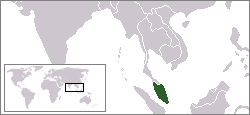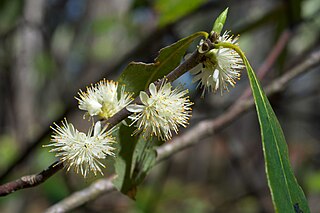
The green-cheeked parakeet, also sometimes known as the green-cheeked conure in aviculture, is a species of bird in subfamily Arinae of the family Psittacidae, the African and New World parrots. It is found in Argentina, Bolivia, Brazil, and Paraguay.

Castilla elastica, the Panama rubber tree, is a tree native to the tropical areas of Mexico, Central America, and northern South America. It was the principal source of latex among the Mesoamerican peoples in pre-Columbian times. The latex gathered from Castilla elastica was converted into usable rubber by mixing the latex with the juice of the morning glory species Ipomoea alba which, conveniently, is typically found in the wild as a vine climbing Castilla elastica. The rubber produced by this method found several uses, including most notably, the manufacture of balls for the Mesoamerican ballgame ōllamaliztli.
Amphitecna molinae is an endangered species of plant in the family Bignoniaceae. It is found in El Salvador, Honduras, and Nicaragua.
Gentlea molinae is a species of plant in the family Primulaceae. It is endemic to Honduras.
Symplocos cordifolia is a species of plant in the family Symplocaceae. It is endemic to Sri Lanka.
Symplocos costata is a species of plant in the family Symplocaceae. It is endemic to Sumatra. It is a vulnerable species threatened by habitat loss.
Symplocos junghuhnii is a species of plant in the family Symplocaceae. It is a tree endemic to Java in Indonesia. It is threatened by habitat loss.
Symplocos lugubris is a species of plant in the family Symplocaceae. It is endemic to Peru.

Symplocos nivea is a species of plant in the family Symplocaceae. It is a tree endemic to Peninsular Malaysia.
Symplocos oligandra is a species of plant in the family Symplocaceae. It is endemic to India. It is threatened by habitat loss.

Symplocos shilanensis is a species of plant in the family Symplocaceae. It is endemic to Taiwan. It is threatened by habitat loss.
Symplocos tacanensis is a species of plant in the family Symplocaceae. It is found in El Salvador and Guatemala. It is threatened by habitat loss and is considered to be a "threatened" species by the International Union for Conservation of Nature and Natural Resources.
Symplocos versicolor is a species of plant in the family Symplocaceae. It is endemic to Sri Lanka.

Symplocos tinctoria is a deciduous or evergreen shrub or tree. It is recognized by pith of twigs chambered; by foliage not notably aromatic when bruised, leaves finely hairy beneath. Shrubs or trees to 17 m tall by 36 cm diameter at breast height. The largest first-year twigs are under 3 mm across, terminal buds with acute tip, scales ciliate. Leaves are 7–15 cm long, margin entire or occasionally some teeth on the apical half, with a sweet taste that may be faint in old leaves. It is conspicuous when in flower; flowers opening before new leaves develop, fragrant, in clusters from axils of previous year's leaves or from just above the leaf scars if the leaves have fallen; the petals are creamy yellow to yellow, with one pistil. Fruits nearly cylindrical to ellipsoid drupes 8–12 mm long, with thin pulp and a hard stone containing one seed; the tip usually retaining parts of the sepals. Foliage is relished by browsing wildlife. A yellow dye may be obtained from bark and leaves. It flowers March to May.

Symplocos anomala is a plant in the family Symplocaceae.
Symplocos buxifolioides is a tree in the family Symplocaceae, native to Borneo. The specific epithet buxifolioides refers to the species' resemblance to Symplocos buxifolia.
Symplocos iliaspaiensis is a plant in the family Symplocaceae, native to Borneo. It is named for Ilias Paie, a plant collector at the Sarawak Herbarium.
Symplocos laeteviridis is a plant in the family Symplocaceae, native to tropical Asia. The specific epithet laeteviridis means 'bright green' and refers to the leaves.
Symplocos zizyphoides is a plant in the family Symplocaceae, native to Borneo. The specific epithet zizyphoides refers to the species' resemblance to those in the genus Ziziphus.
Symplocos crassipes is a plant in the family Symplocaceae, native to Southeast Asia. The specific epithet crassipes means 'thick foot', referring to the stem.






